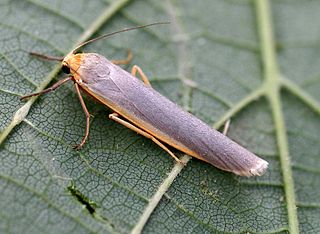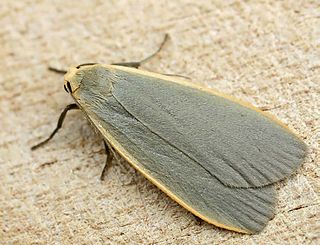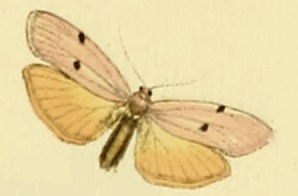Wittia is a genus of moths in the family Erebidae.
Capissa is a monotypic tiger moth genus in the family Erebidae. It was previously treated as a synonym of Eilema. Its only species, Capissa vagesa, is found in the north-western Himalayas, Kashmir, Nepal and Upper Myanmar. Both the genus and species were first described by Frederic Moore; the genus in 1878 and the species in 1860.
Collita is a genus of moths in the family Erebidae. The genus was erected by Frederic Moore in 1878.

Eilema is a genus of moths in the subfamily Arctiinae. The genus was erected by Jacob Hübner in 1819.

Manulea complana, the scarce footman, is a moth of the family Erebidae. The species was first described by Carl Linnaeus in his 1758 10th edition of Systema Naturae. It is found throughout the Palearctic region.

Collita griseola, the dingy footman, is a moth of the family Erebidae. The species was first described by Jacob Hübner in 1803. It is found in Europe and North and South-East Asia.

Wittia sororcula, the orange footman, is a moth of the family Erebidae. The species was first described by Johann Siegfried Hufnagel in 1766. It is found in Europe, Anatolia and further east across the Palearctic to southern Siberia and the Amur basin to China.

Eilema caniola, the hoary footman, is a moth of the family Erebidae. The species was first described by Jacob Hübner in 1808.

Eilema lutarella is a species of moth in the family Erebidae. It is found in North Africa through Central Europe up to the area surrounding the Amur River and Sakhalin. In the north, it is found up to Scandinavia, Komi Republic in European Russia, Vitim river in Siberia.
Zobida is a genus of moths in the subfamily Arctiinae.
Manulea pseudocomplana is a moth of the family Erebidae. It is found from central and southern Europe to Ukraine, Turkey and Iran.

Manulea (Setema) cereola is a moth of the family Erebidae. It is found in Fennoscandia, the Baltic States, European Russia as well as the Alps and Urals. The species was first described by Jacob Hübner in 1803.
Collita vetusta is a moth of the family Erebidae. It is found in Japan, the Russian Far East, northern China and Korea.
Collita coreana is a moth of the family Erebidae. It is found in Korea. Records for the Russian Far East and Japan are probably based on misidentifications of Manulea ussurica.
Collita okanoi is a moth of the family Erebidae. It is found on the southern Kuriles and in Japan.
Collita digna is a moth of the family Erebidae. It is found in the Russian Far East.
Collita chinensis is a moth of the family Erebidae. It is found in Mongolia and China.

Zobida bipuncta is a moth of the subfamily Arctiinae. It is found in Larache, Morocco and the southern part of the Iberian Peninsula.
Tarika is a monotypic moth genus of the subfamily Arctiinae in the family Erebidae. Its only species, Tarika varana, is found in Sikkim, India. The genus and species were both first described by Frederic Moore; the genus in 1878 and the species in 1866.

The Lithosiina are a subtribe of lichen moths in the family Erebidae. The taxon was erected by Gustaf Johan Billberg in 1820.








